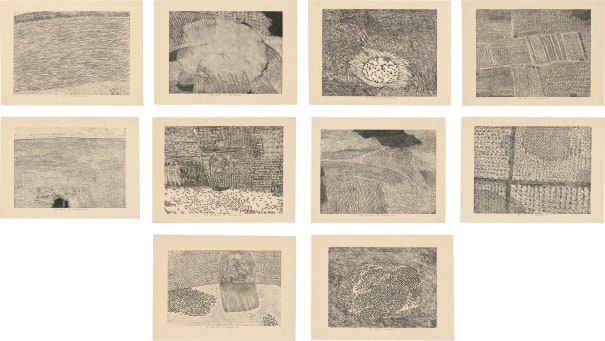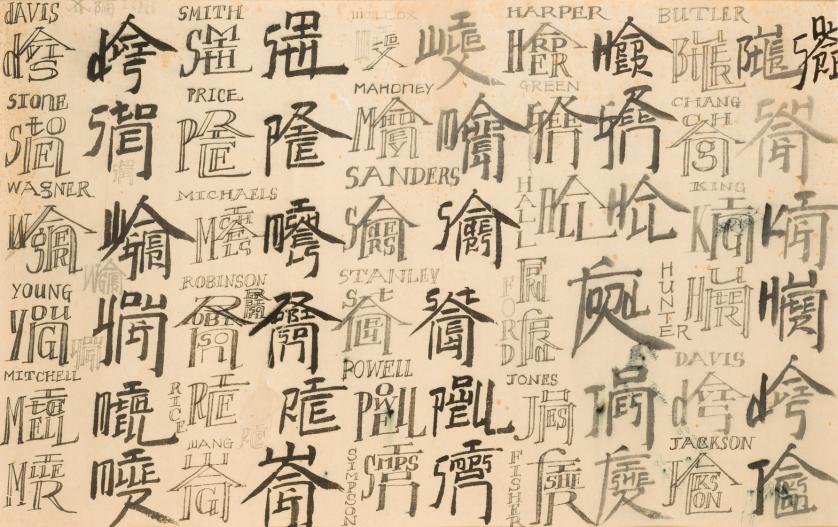Xu Bing Book from the Sky 1987 – 1991 Four hand-made books of paper and ink and one wooden case. Box: 19 3/8 x 3 3/4 x 13 1/8 in. (49.2 x 9.5 x 33.3 cm); Book: 18 x 11 3/4 x 3/4 in. (45.7 x 9.5 x 1.9 cm) each. Signed “Xu Bing [in Chinese and English]” and numbered of 100 on the inside front cover of first book. This work is from an edition of 100.
Provenance Acquired directly from the artist Exhibited Beijing, China Art Gallery, Exhibition of Prints by Xu Bing, October 1988; Beijing, China Art Gallery, China/Avant-Garde, February 1989; Tokyo, Tokyo Gallery, Book from the Sky, 1991; Madison, Elvehjem Museum of Art, Three Installations by Xu Bing, November 30, 1991 – January 19, 1992; Venice, 45th Venice Biennale, 1993; Madrid, Museum National Center de Art Reina Sofia, Cocido y Crudo, 1994; Albany, University Art Museum, Xu Bing: A Book from the Sky, 1996; Albany, Albany State University, Xu Bing Book/Ends, 2000; Arthur M. Sackler Gallery, Smithsonian Institution, Word Play: Contemporary Art by Xu Bing, January - May 2002; Princeton, The P.Y. and Kinmay W. Tang Center for East Asian Art at Princeton University, Book from the Sky, 2003 (other examples exhibited) Literature V. Doran (ed.), China’s New Art, Post 1989, Hong Kong, 1989, p. 198; Elvehjem Museum of Art, ed., Three Installations by Xu Bing, Madison, 1991-1992, pp. 2, 10-17 (illustrated); H. Wu, “A ‘Ghost Rebellion: Notes on Xu Bing’s ‘Nonsense Writing’ and Other Works,” Public Culture 6, no. 2, Winter 1994, pp. 411-417; C. Clunas, Art in China, Oxford, 1997, pp. 220-221 (illustrated); Sonje Museum of Contemporary Art, In Between Limits, Seoul, 1997, pp. 72-73 (illustrated); S. Abe, “No Questions, No Answers: China and A Book from the Sky,” Modern Chinese Literary and Cultural Studies in the Age of Theory: Reimagining a Field, Volume 25 Number 3, Autumn 1998, pp. 169-192; M. Gao ed., Inside Out: New Chinese Art, San Francisco and New York, 1998-1999, p. 56 (illustrated); B. Erickson, “Evolving Meanings in Xu Bing’s Art: A Case Study of Transference,” chinese-art.com, Volume 1 Issue 4, 1999 (illustrated); J. Goodman, “Xu Bing at Jack Tilton and the New Museum,” Art in America, January 1999; E. Heartney, “Children of Mao and Coca-Cola,” Art in America, March 1999, p. 44; S. Abe, “Reading the Sky” in W. Yeh, Cross-Cultural Readings of Chineseness: Narratives, Images, and Interpretations of the 1990s, Berkeley, 2000, pp. 53-79; A. W. Lloyd, “Binding Together Cultures With Cords of Wit,” New York Times, June 18, 2000, p. 35 (illustrated); R. Thorp and R. E. Vinograd, Chinese Art & Culture, New York, 2001, p. 413-414 (illustrated); H. Lu, An Analysis of Conceptual Art 1979 – 1999, Hubei, 2001, p. 11 (illustrated); N. Eickel, ed., The Art of Xu Bing: Words without Meaning, Meaning without Words, Washington D.C., 2001, p. 33-57 (illustrated); H. Cotter, “Calligraphy, Cavorting Pigs and Other Body-Mind Happenings,” New York Times, January 25, 2002 (illustrated); H. Hou, On the Mid-Ground, Hong Kong, 2002, p. 41 (illustrated); M. Koppel-Yang, Semiotic Warfare: The Chinese Avant-Garde, 1979-89, A Semiotic Analysis, Beijing, 2002, p. 3 (illustrated); Centre Pompidou, ed., Alors, La Chine?, Paris, 2003, p. 252 (illustrated); B. Xu, Xu Bing, Taipei, 2003, pp. 10-18 (illustrated); O. H. Ho, The Influence of the West on Chinese Modern Art, Chinese Cross-currents, July – September 2004, Volume 1 Number 3, p. 27 (illustrated); Z. Zhang, Xu Bing and Cai Guo-qiang: Where Heaven and Earth Meet, Beijing, 2005, pp. 6, 16-17 (illustrated); J. Silbergeld and D. Ching, eds., Persistence/Transformation: Text as Image in the Art of Xu Bing, Princeton, 2006, pp. 19-21, 25-57, 99-103 (illustrated) Catalogue Essay Xu Bing’s iconic installation Book From the Sky is arguably the artist’s most famous work. The entire work consists of an installation comprising books, scrolls, and paper, all printed with Xu’s imaginary, 4000-character language. Xu invented a vocabulary of four thousand 'false' Chinese characters inspired by Song Dynasty calligraphy and then painstakingly hand-cut each one onto wooden printing blocks. The characters are made up of Chinese-language radicals but are entirely imaginary and thus meaningless. Xu’s invented Chinese script, which required years of painstaking labor to complete, challenges and revolutionizes the history of
Xu Bing Book from the Sky 1987 – 1991 Four hand-made books of paper and ink and one wooden case. Box: 19 3/8 x 3 3/4 x 13 1/8 in. (49.2 x 9.5 x 33.3 cm); Book: 18 x 11 3/4 x 3/4 in. (45.7 x 9.5 x 1.9 cm) each. Signed “Xu Bing [in Chinese and English]” and numbered of 100 on the inside front cover of first book. This work is from an edition of 100.
Provenance Acquired directly from the artist Exhibited Beijing, China Art Gallery, Exhibition of Prints by Xu Bing, October 1988; Beijing, China Art Gallery, China/Avant-Garde, February 1989; Tokyo, Tokyo Gallery, Book from the Sky, 1991; Madison, Elvehjem Museum of Art, Three Installations by Xu Bing, November 30, 1991 – January 19, 1992; Venice, 45th Venice Biennale, 1993; Madrid, Museum National Center de Art Reina Sofia, Cocido y Crudo, 1994; Albany, University Art Museum, Xu Bing: A Book from the Sky, 1996; Albany, Albany State University, Xu Bing Book/Ends, 2000; Arthur M. Sackler Gallery, Smithsonian Institution, Word Play: Contemporary Art by Xu Bing, January - May 2002; Princeton, The P.Y. and Kinmay W. Tang Center for East Asian Art at Princeton University, Book from the Sky, 2003 (other examples exhibited) Literature V. Doran (ed.), China’s New Art, Post 1989, Hong Kong, 1989, p. 198; Elvehjem Museum of Art, ed., Three Installations by Xu Bing, Madison, 1991-1992, pp. 2, 10-17 (illustrated); H. Wu, “A ‘Ghost Rebellion: Notes on Xu Bing’s ‘Nonsense Writing’ and Other Works,” Public Culture 6, no. 2, Winter 1994, pp. 411-417; C. Clunas, Art in China, Oxford, 1997, pp. 220-221 (illustrated); Sonje Museum of Contemporary Art, In Between Limits, Seoul, 1997, pp. 72-73 (illustrated); S. Abe, “No Questions, No Answers: China and A Book from the Sky,” Modern Chinese Literary and Cultural Studies in the Age of Theory: Reimagining a Field, Volume 25 Number 3, Autumn 1998, pp. 169-192; M. Gao ed., Inside Out: New Chinese Art, San Francisco and New York, 1998-1999, p. 56 (illustrated); B. Erickson, “Evolving Meanings in Xu Bing’s Art: A Case Study of Transference,” chinese-art.com, Volume 1 Issue 4, 1999 (illustrated); J. Goodman, “Xu Bing at Jack Tilton and the New Museum,” Art in America, January 1999; E. Heartney, “Children of Mao and Coca-Cola,” Art in America, March 1999, p. 44; S. Abe, “Reading the Sky” in W. Yeh, Cross-Cultural Readings of Chineseness: Narratives, Images, and Interpretations of the 1990s, Berkeley, 2000, pp. 53-79; A. W. Lloyd, “Binding Together Cultures With Cords of Wit,” New York Times, June 18, 2000, p. 35 (illustrated); R. Thorp and R. E. Vinograd, Chinese Art & Culture, New York, 2001, p. 413-414 (illustrated); H. Lu, An Analysis of Conceptual Art 1979 – 1999, Hubei, 2001, p. 11 (illustrated); N. Eickel, ed., The Art of Xu Bing: Words without Meaning, Meaning without Words, Washington D.C., 2001, p. 33-57 (illustrated); H. Cotter, “Calligraphy, Cavorting Pigs and Other Body-Mind Happenings,” New York Times, January 25, 2002 (illustrated); H. Hou, On the Mid-Ground, Hong Kong, 2002, p. 41 (illustrated); M. Koppel-Yang, Semiotic Warfare: The Chinese Avant-Garde, 1979-89, A Semiotic Analysis, Beijing, 2002, p. 3 (illustrated); Centre Pompidou, ed., Alors, La Chine?, Paris, 2003, p. 252 (illustrated); B. Xu, Xu Bing, Taipei, 2003, pp. 10-18 (illustrated); O. H. Ho, The Influence of the West on Chinese Modern Art, Chinese Cross-currents, July – September 2004, Volume 1 Number 3, p. 27 (illustrated); Z. Zhang, Xu Bing and Cai Guo-qiang: Where Heaven and Earth Meet, Beijing, 2005, pp. 6, 16-17 (illustrated); J. Silbergeld and D. Ching, eds., Persistence/Transformation: Text as Image in the Art of Xu Bing, Princeton, 2006, pp. 19-21, 25-57, 99-103 (illustrated) Catalogue Essay Xu Bing’s iconic installation Book From the Sky is arguably the artist’s most famous work. The entire work consists of an installation comprising books, scrolls, and paper, all printed with Xu’s imaginary, 4000-character language. Xu invented a vocabulary of four thousand 'false' Chinese characters inspired by Song Dynasty calligraphy and then painstakingly hand-cut each one onto wooden printing blocks. The characters are made up of Chinese-language radicals but are entirely imaginary and thus meaningless. Xu’s invented Chinese script, which required years of painstaking labor to complete, challenges and revolutionizes the history of








.jpg)





.jpg)
Try LotSearch and its premium features for 7 days - without any costs!
Be notified automatically about new items in upcoming auctions.
Create an alert